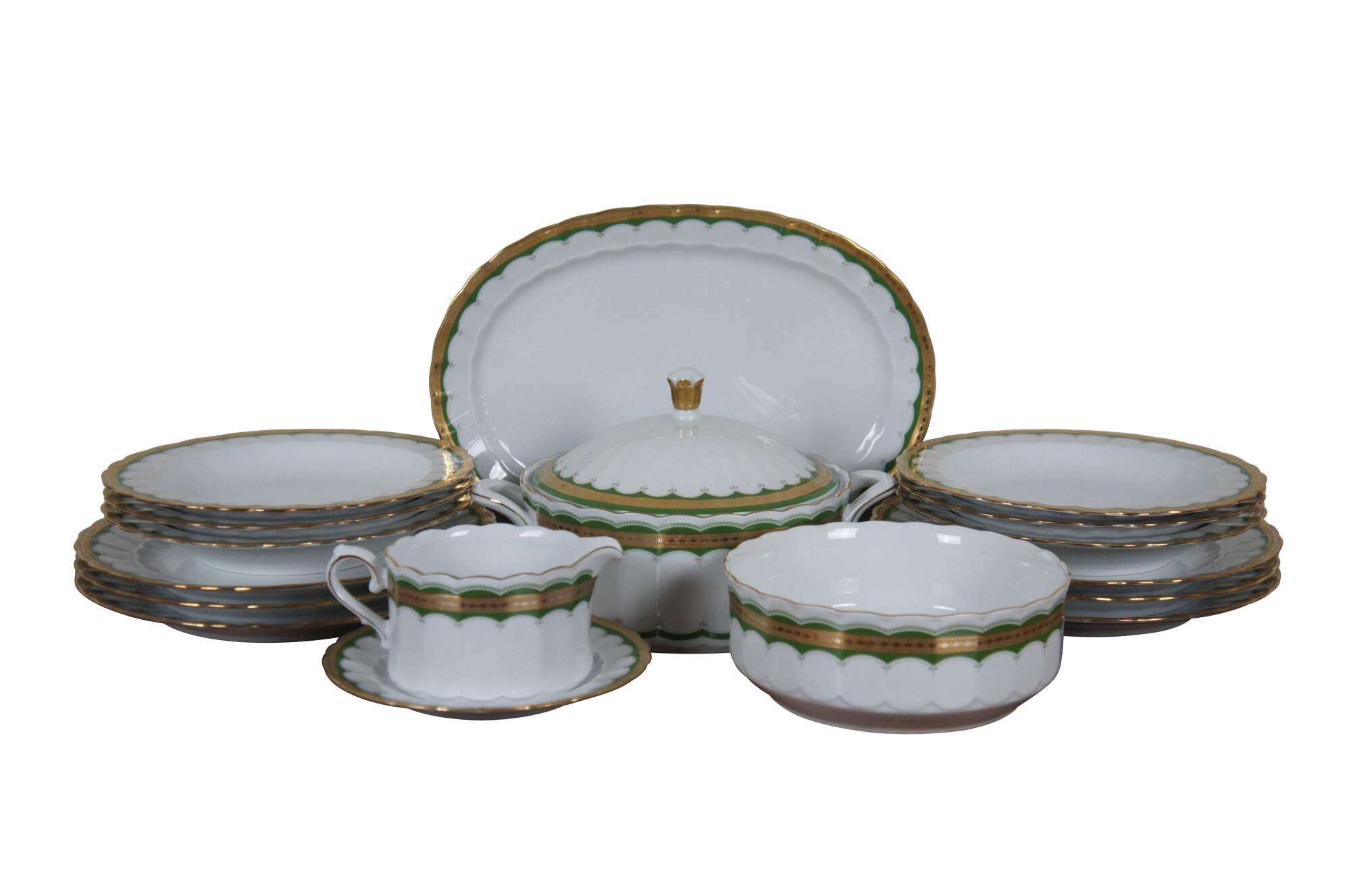
Shipping:
Free Shipping Included
Delivery:
Estimated 2-15 Business Days
Payments:
Credit Card, Check, Cash, PayPal, Apple Pay, Venmo
Returns:
30 Days 100% Money Back Guarantee, Buyer Pays Return Shipping
Description
Mid to early 20th century set of Eschenbach china. Scalloped edges, decorated with a Neoclassical scalloped swag spearpoint motif in green, topped with gilt bands. Set includes: Oval Serving Platter, Round Lidded Serving Dish, Round Serving Bowl, Creamer/Gravy Boat, Under Plate, 6 Salad Plates, 6 Bowls
"Eschenbach is the trade name used by a German porcelain manufactory located in Windischeschenbach. Porzellanfabrik Eduard Haberländer (1913 until 1929) - The founder of the factory and councilor to the board of commerce Eduard Haberländer had been planning a porcelain factory in Windischeschenbach since 1906, however it took until 1913 before he could finally realize his plans. First production started in 1916 and was restricted to staple commodities, the product range was cheap and simple and production capacity was still very low. Porzellanfabrik Oscar Schaller & Co. Nachfolger (1929 until 1950) - During 1929 the factory was taken over by Porzellanfabrik Oscar Schaller & Co. Nachfolger located in Schwarzenbach (Saxony-Anhalt), which at that point was a branch of the Gebrüder Winterling OHG in Röslau (Upper Franconia, Bavaria). Based on a new concept, products under the Eschenbach brand were changed. Up until 1935, the status of quality porcelain had been established, resulting in a strong economic upturn. But World War II left scars even in Windischeschenbach. The reason that only a small range of china from the 1913 to 1945 period still exists is that all china design ranges as well as all brochures and leaflets and nearly all company documents and correspondence were lost during the eviction by American soldiers. To get production on the way again, the factory used molds from the defunct Porzellan-Manufaktur Allach-München GmbH and the resulting product range of course mostly included ornamental plates and tableware. For the first ten years after World War II, the factory went through an extensive expansion and modernization process with a later total of five tunnel kilns without a loss of production capacity. Porzellanfabrik Gebrüder Winterling AG (1950 until 2000) - In 1950, the Winterling company had corporation status and gave out shares, the main shareholders being the Winterling family members. All daughter companies were re-named to Gebrüder Winterling AG and most marks used up until then were changed. Next to normal household products, the factory started to specialize on hotel porcelain and around 1977 employed approximately 700 workers. Triptis Porzellan GmbH & Co. KG, Werk Windischeschenbach (2000 until 2003) - After the bankruptcy of the Winterling AG in November 2000, the assets were taken over by the Triptis Porzellan GmbH & Co. KG located in Triptis (Thuringia). The factory produced high quality household and hotel porcelain under the trademark Eschenbach Porzellan. The Triptis management seemed only to be interested in the trademarks related to the Windischeschenbach facility and closed the factory in December 2003. But a company can not survive alone with a bunch of trademarks and it soon became obvious that the Triptis management had bitten off more than they could chew. Confronted with large scaled financial problems, Triptis themselves became insolvent on October 7th 2004 and had to file for bankruptcy a month later. In June 2005, the Triptis company was re-established as Neue Porzellanfabrik Triptis GmbH and have continued business to the present day." (Source: Porcelain Marks & More)
Condition
Good Overall - Light wear
Dimensions
Lidded Dish - 10.25" x 8" x 6" / Creamer - 6" x 4.25" x 3" (Width x Depth x Height)